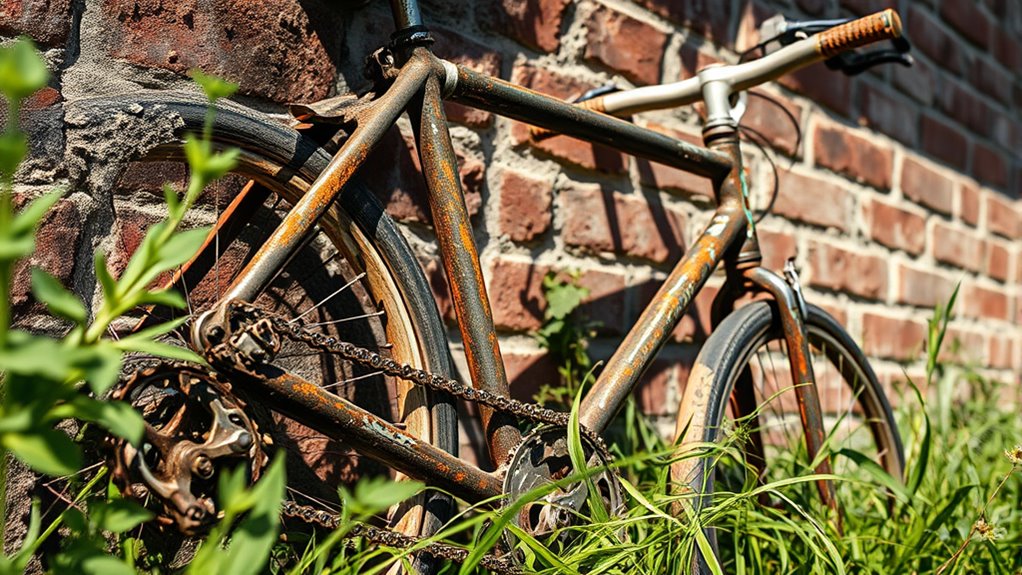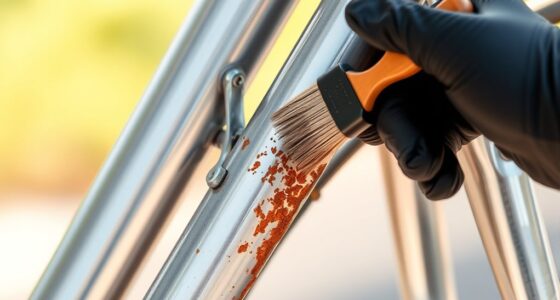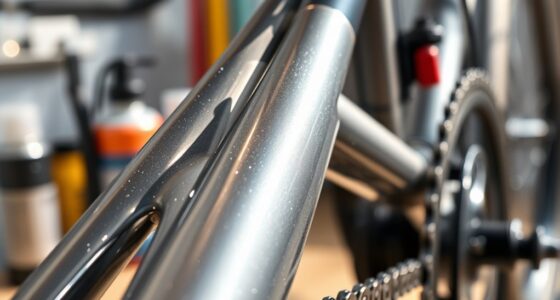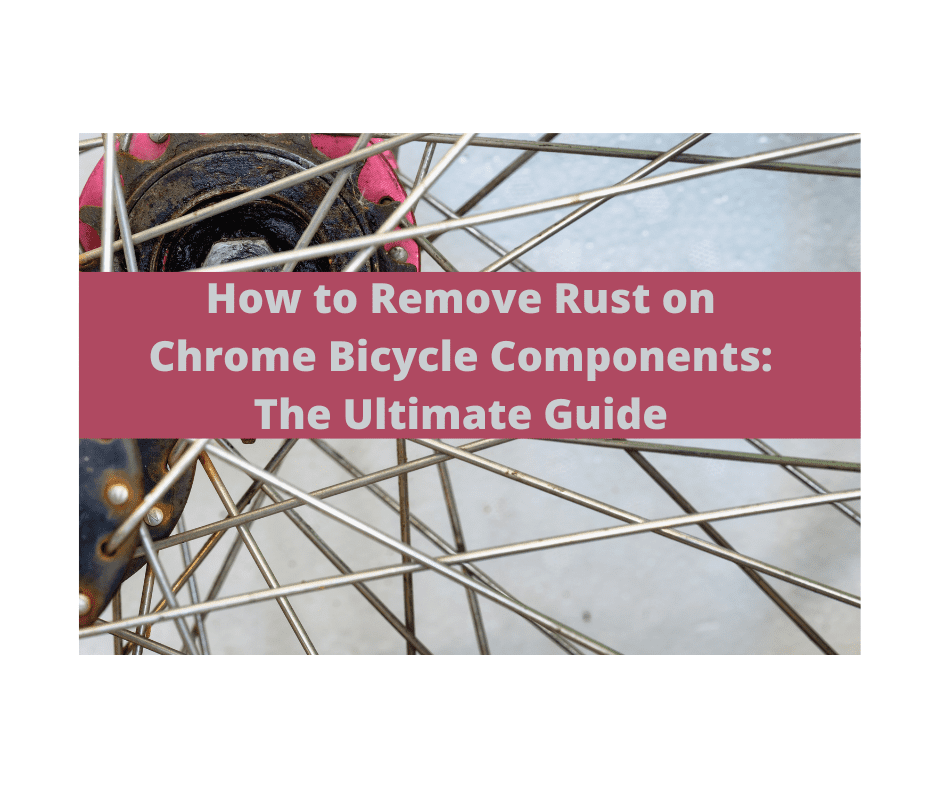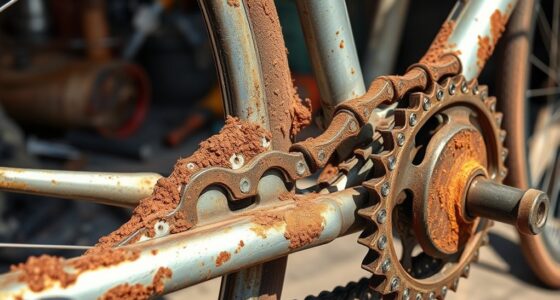Bikes rust when they’re exposed to moisture, oxygen, and sometimes salt, which accelerate the corrosion process. Leaving your bike outside or in damp areas invites water and air to react with the metal, causing oxidation and weakening the frame and parts. Scratches and dirt trap moisture, making rust formation faster. Proper maintenance, storage, and protective coatings can help prevent this. If you want to discover how to keep your bike in top shape, keep going.
Key Takeaways
- Exposure to moisture and oxygen causes metal oxidation, leading to rust formation on bikes.
- Salt from coastal areas or winter road treatment accelerates corrosion through electrochemical reactions.
- Scratches or chipped paint expose raw metal, making it more vulnerable to rust.
- Humidity and damp environments increase oxidation rates and promote rust development.
- Lack of regular cleaning and maintenance allows dirt, grime, and moisture to trap and accelerate corrosion.

Bikes rust because exposure to moisture and oxygen causes metal components to oxidize over time. When you leave your bike outside or in damp environments, the combination of water and air accelerates the natural process of corrosion. Rust not only makes your bike look unattractive but also weakens its structural integrity, making it less safe to ride. Understanding how rust forms and what contributes to it helps you take better rust prevention measures, ensuring your bike remains in good condition longer.
Bikes rust due to moisture and oxygen causing metal oxidation and corrosion over time.
Corrosion factors play a notable role in how quickly your bike rusts. Humidity is a primary culprit; high moisture levels in the air increase the likelihood of oxidation. Rain, puddles, or even sweating due to temperature changes can introduce enough water to promote rust. Salt, especially in coastal areas or from road salt used in winter, worsens corrosion because it accelerates the electrochemical reactions involved in rust formation. Dirt and grime can trap moisture against metal surfaces, creating a perfect environment for rust to develop if not cleaned regularly. Additionally, scratches or chips in paint or protective coatings expose raw metal, making those spots more vulnerable to corrosion factors. Proper maintenance, including regular filter cleaning****, can help protect your bike from moisture buildup, especially in humid environments.
To prevent rust, you need to implement effective rust prevention strategies. Regularly cleaning your bike removes dirt, salt, and moisture that could contribute to oxidation. After cleaning, dry your bike thoroughly to eliminate any lingering water that might hide in crevices or joints. Applying a light coat of protective oil or bike-specific lubricant on metal parts creates a barrier against moisture and oxygen, reducing the chances of rust formation. Consider using rust-resistant paints or coatings on vulnerable areas to add an extra layer of defense. When storing your bike, choose a dry, sheltered location—preferably indoors—to minimize exposure to humidity and rain.
It’s also helpful to inspect your bike frequently for signs of rust or damage to protective coatings. Catching rust early allows you to remove it before it spreads, using rust remover or fine sandpaper, and then reapply protective treatments. Be mindful of the environment where you keep your bike; avoiding damp basements or garages with poor ventilation substantially lowers the risk of rusting. By understanding corrosion factors and actively implementing rust prevention techniques, you can extend the lifespan of your bike and keep it looking and functioning like new. Proper care doesn’t require much effort but can save you time and money by avoiding extensive repairs caused by rust damage over time.
Frequently Asked Questions
Can Bike Rust Be Completely Removed?
Yes, bike rust can be completely removed if you act promptly. Regular rust prevention and proper bike maintenance are key to keeping rust at bay. Use rust remover products or a mixture of vinegar and baking soda to treat affected areas. Scrub gently with a wire brush or steel wool. After cleaning, apply a protective coating or bike lubricant to prevent future rust, ensuring your bike stays in top shape.
How Does Salt Accelerate Bike Rusting?
Ever wonder how salt speeds up rust on your bike? Salt accelerates bike rust by promoting salt corrosion, which happens when salt reacts with metal, forming corrosive compounds. Environmental factors like moisture and temperature also play a role. When salt is present, it lowers the metal’s resistance to oxidation, making rust form faster. So, if you ride in salty conditions, your bike’s metal faces a much quicker deterioration.
Is Rust More Common on Certain Bike Parts?
Yes, rust is more common on certain bike parts like the chain, sprockets, and handlebars. These areas have metal components more exposed to moisture and salt, which accelerates metal corrosion. The material composition also matters; parts made from steel or iron are more prone to rust than those made from aluminum or carbon fiber. Regular maintenance and protective coatings can help prevent rust formation on these vulnerable parts.
Can Rust Damage Be Prevented With Coatings?
Imagine your bike exposed to rain and mud, and rust begins to form. Yes, rust damage can be prevented with coatings. Protective coatings enhance corrosion resistance, creating a barrier that stops moisture from reaching metal surfaces. Applying paint, varnish, or specialized anti-rust coatings regularly helps maintain your bike’s condition and prevents costly repairs. You can extend your bike’s lifespan considerably by using these protective coatings effectively.
How Long Does It Take for a Bike to Rust?
It can take anywhere from a few days to several months for your bike to start rusting, depending on environmental factors. If exposed to moisture, salt, or humidity, metal corrosion happens faster. Regularly cleaning and drying your bike, especially after rain or snow, slows down the process. Applying protective coatings also helps. So, stay proactive—maintain your bike to prevent rust and extend its lifespan.
Conclusion
So, don’t assume rust is inevitable. With regular cleaning, proper storage, and timely maintenance, you can keep your bike looking great and functioning smoothly. Some might think investing time isn’t worth it, but think of it this way: a well-maintained bike lasts longer, saves you money, and keeps you safer on the road. Rust isn’t just a cosmetic issue — it can weaken your bike’s structure over time. Stay proactive, and your bike will thank you.
